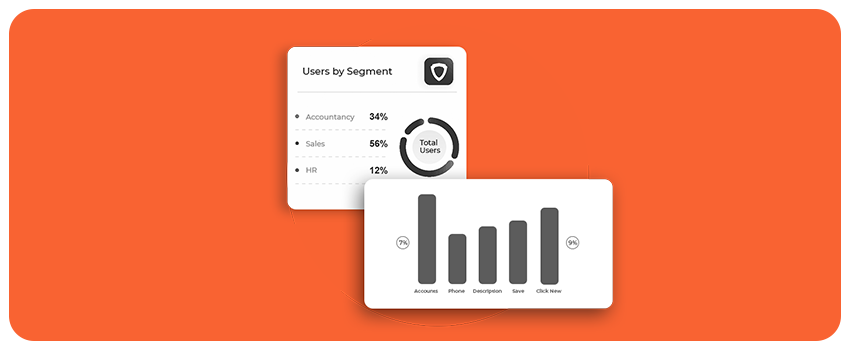Organizations that are expanding or looking to improve their competitive edge are investing in digital transformation initiatives. In fact, in a recent report, IDC stated that digital transformation investments will be accelerated at a CAGR of 16.5% which is higher than 2019-2021.*
This is driving enterprises towards new technologies. But to stay competitive businesses need new strategies to make most of their digital investments.
This is where a Digital Adoption Platform comes in and helps organizations to make most of their enterprise applications. However, there are a variety of Digital Adoption Solutions available in the market, and making the right choice could be challenging.
In this blog post, we will discuss how to approach digital adoption and what type of solution could be the right fit to achieve that.
What is a Digital Adoption Platform?
A Digital Adoption Platform sits over any web-based application to provide a seamless experience, increase employee efficiency, and boost software ROI. It achieves this by analyzing application usage patterns and guiding the employees at the exact point of need.
A Digital Adoption Platform empowers the workforce to be self-reliant and not dependent on any particular instructor or trainer. It guides them at the exact moment of need and helps them understand the processes completely.
Irrespective of the complexity of the application or the knowledge level of your employees a digital adoption platform should be able to help them in accomplishing their objectives.
Not only that it should also be in a position to ensure that they are compliant with organizational guidelines while entering data, filling forms, or completing tasks on any given application.
Now that we understand the digital adoption platform it is time to explore how to approach it.
The right approach to Digital Adoption
Companies that are transforming usually opt for new applications and processes. As a result, they invest in means that can enable their employees to adopt the new ways.
A traditional digital adoption platform might help your employees to navigate through the application and you can create thousands of content that can cater to their needs. But too many options without any purpose will create a new problem. These problems could be confusion for employees and time consumption for your L&D team.
Either of which is unaffordable for a growing organization. So, to counter these enterprises have started using digital adoption platforms like Apty which focuses on creating a relevant experience for the employees and not overwhelming the end-users with too much content.
A digital adoption should be 5 phase process and an ideal digital adoption platform should help you achieve that.
5 Phases of Digital Adoption Platform
- Analyze the usage pattern
- Stitch a customized onboarding experience
- Create contextual content
- Define goals and objectives
- Focus on Business Process Compliance
1. Analyze the usage pattern
You can create predefined activities with Apty and then start analyzing how differently the users are using the application when compared to the predefined process.
You can analyze business processes as Apty empowers organizations to analyze multiple applications at a time which helps to understand how the users are traveling from one app to another.
You can collect data like application usage, average activity per session, and error trends. It further enables you to :
- Measure how users interact at each touchpoint with the applications.
- The efficiency they complete the businesses processes.
- Understand usage based on use cases and not just signing.
- Create an application navigation roadmap and the ability to track how a user is performing against it.
- Generate data based on user segments like job roles, regions, departments, business verticals, and different interests.
You can go further beyond this and create an activity funnel that comprises a number of steps that a user has to take before completing a step.

This funnel shows all the steps of the activity with a percentage bar that shows the drop-off rate. It helps to understand the step which is causing trouble for the users or at what step they leave the process.
Based on this then you can strategize not only your digital adoption strategy but also training and transformation efforts.
2. Stitch a customized onboarding experience
You can easily create an onboarding checklist with Apty which helps the users to get accustomed to the new processes, and features of any application.
The onboarding checklists comprise tasks in sequential order. One by one the users have to complete the tasks to at least gain the minimum required knowledge.
It guides users at each step and doesn’t allow the users to get overwhelmed with the complexities of the application or technical aspects that are associated with it. It helps them to focus on their actual job rather than getting bothered about the application.
3. Create contextual content
Once the users are familiar with the application via the onboarding checklist, it is time to help them with deeper and contextual content that can drive them to become power users.
Digital Adoption Platform like Apty has an in-app help-deck that sits within the application and can be accessed by users at all times. Users can kickstart their learning without being dependent on anyone, it is a perfect balance of on-demand training and microlearning.

Apty helps the application owners to create content in multiple formats like PDFs, PPTs, videos, SCORM, and walkthroughs. You can also place knowledge base links that can guide the user to get in-depth knowledge on a particular aspect of the application
It also enables you to create customized content for each user group in many international languages. This helps an organization to provide consistent training and onboarding experience to all its users and break the international barriers.
4. Define goals and objectives
Now that you have analyzed and created content that your employees need. It is time to measure the outcome generated out of your digital adoption and training strategy. Modern digital adoption platforms are powered with goals feature which is an advanced monitoring system.
Goals are created based on the requirement of the organization and can vary based on the web application that your organization use.
Creating goals within Apty helps the organization to make its priorities clear. You can set a target date within which the users must complete their tasks. It helps the application owners to monitor and predict the progress of the business process goals and receive alerts if the overall adoption is at risk.
You can also map which segment of the user is causing failure and send alerts to them via Apty’s platform. Moreover, you can create content and information that will help this group to overcome the hurdle and complete their tasks. As goals help to understand at what point this segment of users is facing the problem.
All these aspects of tracking and monitoring goals help the business to improve employee performance and make the most out of their application.
5. Focus on Business Process Compliance
Digital Adoption is a never-ending cycle and a major part of digital adoption is analyzing contextual guidance and optimization. But at the core of it, any organization aims to ensure that the employees are compliant too.

Businesses that are growing want clean data to make crucial decisions. With Apty’s data validation and contextual walkthroughs, the users are guided to accomplish their tasks in the intended manner which provides the business with clean data.
It ensures that employees are business process compliant while completing their tasks. This enables organizations with relevant data that they can trust and rely on.
Way forward!
Businesses are focusing on digital adoption as it helps them to ensure a successful transformation. But the understanding is limited as some of the organization thinks that it is a one-time thing.
The absolute state of digital adoption can never be achieved with mere training and onboarding strategy. It is complex and deeper than that, you need a tool that can help you analyze, create and optimize the complete business processes and in turn your digital adoption strategy.













